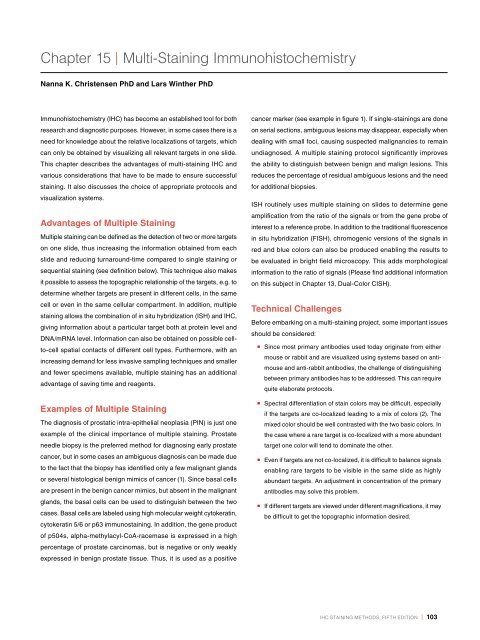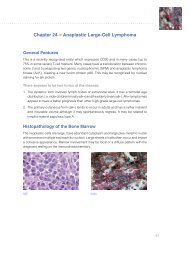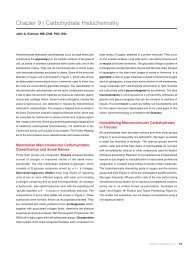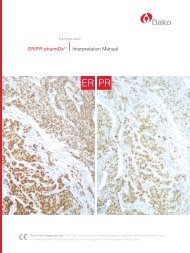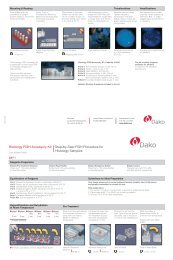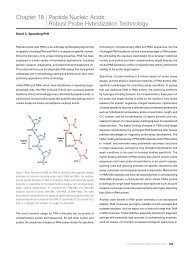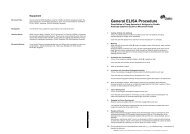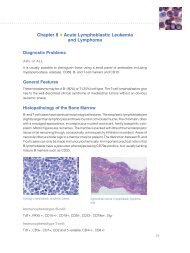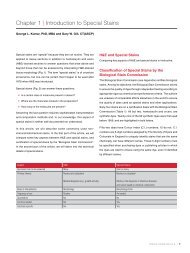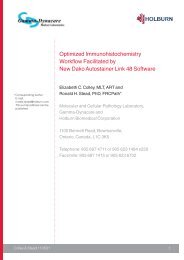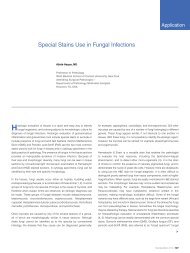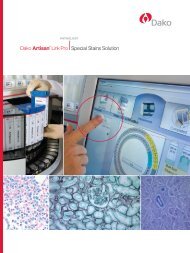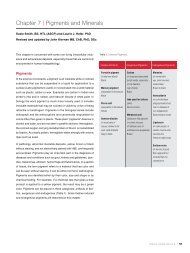Chapter 15 | Multi-Staining Immunohistochemistry - Dako
Chapter 15 | Multi-Staining Immunohistochemistry - Dako
Chapter 15 | Multi-Staining Immunohistochemistry - Dako
You also want an ePaper? Increase the reach of your titles
YUMPU automatically turns print PDFs into web optimized ePapers that Google loves.
<strong>Chapter</strong> <strong>15</strong> | <strong>Multi</strong>-<strong>Staining</strong> <strong>Immunohistochemistry</strong><br />
Nanna K. Christensen PhD and Lars Winther PhD<br />
<strong>Immunohistochemistry</strong> (IHC) has become an established tool for both<br />
research and diagnostic purposes. However, in some cases there is a<br />
need for knowledge about the relative localizations of targets, which<br />
can only be obtained by visualizing all relevant targets in one slide.<br />
this chapter describes the advantages of multi-staining IHC and<br />
various considerations that have to be made to ensure successful<br />
staining. It also discusses the choice of appropriate protocols and<br />
visualization systems.<br />
Advantages of <strong>Multi</strong>ple <strong>Staining</strong><br />
<strong>Multi</strong>ple staining can be defined as the detection of two or more targets<br />
on one slide, thus increasing the information obtained from each<br />
slide and reducing turnaround-time compared to single staining or<br />
sequential staining (see definition below). this technique also makes<br />
it possible to assess the topographic relationship of the targets, e.g. to<br />
determine whether targets are present in different cells, in the same<br />
cell or even in the same cellular compartment. In addition, multiple<br />
staining allows the combination of in situ hybridization (ISH) and IHC,<br />
giving information about a particular target both at protein level and<br />
dna/mRna level. Information can also be obtained on possible cellto-cell<br />
spatial contacts of different cell types. Furthermore, with an<br />
increasing demand for less invasive sampling techniques and smaller<br />
and fewer specimens available, multiple staining has an additional<br />
advantage of saving time and reagents.<br />
Examples of <strong>Multi</strong>ple <strong>Staining</strong><br />
the diagnosis of prostatic intra-epithelial neoplasia (PIn) is just one<br />
example of the clinical importance of multiple staining. Prostate<br />
needle biopsy is the preferred method for diagnosing early prostate<br />
cancer, but in some cases an ambiguous diagnosis can be made due<br />
to the fact that the biopsy has identified only a few malignant glands<br />
or several histological benign mimics of cancer (1). Since basal cells<br />
are present in the benign cancer mimics, but absent in the malignant<br />
glands, the basal cells can be used to distinguish between the two<br />
cases. Basal cells are labeled using high molecular weight cytokeratin,<br />
cytokeratin 5/6 or p63 immunostaining. In addition, the gene product<br />
of p504s, alpha-methylacyl-Coa-racemase is expressed in a high<br />
percentage of prostate carcinomas, but is negative or only weakly<br />
expressed in benign prostate tissue. thus, it is used as a positive<br />
cancer marker (see example in figure 1). If single-stainings are done<br />
on serial sections, ambiguous lesions may disappear, especially when<br />
dealing with small foci, causing suspected malignancies to remain<br />
undiagnosed. a multiple staining protocol significantly improves<br />
the ability to distinguish between benign and malign lesions. this<br />
reduces the percentage of residual ambiguous lesions and the need<br />
for additional biopsies.<br />
ISH routinely uses multiple staining on slides to determine gene<br />
amplification from the ratio of the signals or from the gene probe of<br />
interest to a reference probe. In addition to the traditional fluorescence<br />
in situ hybridization (FISH), chromogenic versions of the signals in<br />
red and blue colors can also be produced enabling the results to<br />
be evaluated in bright field microscopy. this adds morphological<br />
information to the ratio of signals (Please find additional information<br />
on this subject in <strong>Chapter</strong> 13, dual-Color CISH).<br />
Technical Challenges<br />
Before embarking on a multi-staining project, some important issues<br />
should be considered:<br />
Since most primary antibodies used today originate from either<br />
mouse or rabbit and are visualized using systems based on antimouse<br />
and anti-rabbit antibodies, the challenge of distinguishing<br />
between primary antibodies has to be addressed. this can require<br />
quite elaborate protocols.<br />
Spectral differentiation of stain colors may be difficult, especially<br />
if the targets are co-localized leading to a mix of colors (2). the<br />
mixed color should be well contrasted with the two basic colors. In<br />
the case where a rare target is co-localized with a more abundant<br />
target one color will tend to dominate the other.<br />
even if targets are not co-localized, it is difficult to balance signals<br />
enabling rare targets to be visible in the same slide as highly<br />
abundant targets. an adjustment in concentration of the primary<br />
antibodies may solve this problem.<br />
If different targets are viewed under different magnifications, it may<br />
be difficult to get the topographic information desired.<br />
IHC StaInIng MetHodS, FIFtH edItIon | 103
<strong>Multi</strong>-<strong>Staining</strong> <strong>Immunohistochemistry</strong><br />
Pre-treatment<br />
<strong>Multi</strong>ple staining, like single staining, can be performed on both<br />
formalin-fixed, paraffin-embedded tissue sections, frozen sections,<br />
cell smears and cytospin preparations. <strong>Multi</strong>ple staining is constrained<br />
by the fact that it may not be possible to find one tissue pre-treatment<br />
protocol that is optimal for all targets. often protocols optimized for<br />
individual stainings differ from one target to the other, e.g. different<br />
target retrieval methods may be used. In this case, it may be necessary<br />
to determine a method that allows all targets to be stained, although<br />
the method may be sub-optimal for some targets.<br />
In cases where targets of different abundance are to be stained, a<br />
method must be selected to best balance the signals. Combining<br />
ISH and IHC on one slide is particularly challenging because targets<br />
require very different pre-treatment protocols. Since ISH processes<br />
such as dna denaturing are not compatible with the presence of the<br />
antibodies for IHC, the ISH protocol is normally performed first.<br />
<strong>Multi</strong>-<strong>Staining</strong> Method Selection<br />
to ensure success, IHC staining must be carefully planned. this is<br />
even more important with multi–staining. If primary antibodies, both<br />
directly-labeled and unlabeled and from different host-species, are<br />
commercially available, there are several different staining methods<br />
that one can choose. However, very often the choice may be limited<br />
by the reagents available (3). Care must be taken to avoid crossreactivity<br />
between reagents. a flow chart or similar aid might prove<br />
useful in selecting the best method.<br />
In general, staining methods can be divided into the following classes:<br />
Sequential staining: By this method, one staining procedure<br />
succeeds another. For example, the first primary antibody is applied<br />
to the tissue section followed by a labeled detection system such as<br />
streptavidin-biotin horseradish peroxidase (HRP), with a chromogen<br />
such as daB. the second primary antibody is applied only after the<br />
excess daB is rinsed off, followed by labeling with a streptavidinbiotin<br />
alkaline phosphatase (aP) detection system and a colored<br />
chromogen. the biggest advantage of sequential staining is that by<br />
this procedure problems related to cross-reactivity are avoided.<br />
104 | IHC StaInIng MetHodS, FIFtH edItIon<br />
a sequential staining is shown in Figure 1. Here, the primary and<br />
secondary antibodies from the first staining were eluted before the<br />
staining of the next target was performed. the disadvantages of<br />
sequential staining are: the method cannot be used for co-localized<br />
targets, the technique often leads to a long staining protocol<br />
and carries an inherent risk of incorrect double staining due to<br />
insufficient elution of one set of reagents before application of the<br />
next reagent.<br />
Figure 1. Sequential double staining method performed with the EnVision TM G⎜2<br />
Doublestain Kit using polyclonal anti-kappa light chains (red) and polyclonal<br />
anti-lambda light chains (brown) as primary antibodies. Formalin-fixed, paraffinembedded<br />
tissue sections from tonsils.<br />
elution may become an issue with some high-affinity primary<br />
antibodies as these may remain at their binding site, leading to<br />
spurious double stained structures. elution also risks denaturing<br />
epitopes of antigens to be visualized subsequently. Furthermore, for<br />
some chromogens there is a risk that the first chromogen (daB in<br />
particular) may shield other targets. this technique is, therefore, not<br />
recommended for evaluation of mixed colors at sites of co-localization,<br />
because not all reaction products are capable of surviving the rigorous<br />
washing required to remove the antibodies. to avoid such problems<br />
and blurry staining results, it is recommended to use the most “robust”<br />
dyes such as daB, Fast Red, aeC and X-gal first followed by other<br />
less “robust” dyes.
Simultaneous staining: In a simultaneous double stain, the primary<br />
antibodies can be applied simultaneously. the advantage of this<br />
method is that it is less time-consuming because the reagents can be<br />
mixed together. However, the technique can only be used, if suitable<br />
primary antibodies are available. two methods can be adopted: a<br />
direct method with directly-labeled primary antibodies, or an indirect<br />
method based on unlabeled primary antibodies raised in different host<br />
species, or of different Ig isotype or Igg subclass (4).<br />
a simple example of the direct method is when the primary antibodies<br />
are fluorescence-labeled to allow direct visualization. this avoids<br />
cross-reactivity, but is rarely practical since some form of amplification<br />
is necessary to get sufficient signal. alternatively, the primary<br />
antibodies may be conjugated directly with enzymes, biotin, haptens or<br />
fluorochromes, subsequently employing the corresponding secondary<br />
antibody or streptavidin reagent. this is less time-consuming than the<br />
sequential method, since primary and secondary antibodies can be<br />
mixed together in two incubation steps. However, it requires avoiding<br />
all cross-reactivity.<br />
With the indirect method it is also possible to apply time-saving<br />
antibody cocktails since the primary antibodies are recognized<br />
by different secondary antibodies (for an example, see Figure 2).<br />
generally, it is advantageous to use secondary antibodies raised<br />
in the same host in order to prevent any unexpected interspecies<br />
cross-reactivity. one example of such a system is the new enVision<br />
duoFLeX from dako. this system applies a mixture of primary<br />
antibodies of mouse and rabbit origin, followed by a mixture of the<br />
secondary goat-anti mouse and goat-anti-rabbit antibodies labeled<br />
with HRP and aP, respectively. Finally, the chromogens are applied<br />
sequentially. the result is a double stain where the primary mouse<br />
antibodies are stained brown with daB and the primary rabbit<br />
antibodies are stained red with Permanent Red (for an example,<br />
see Figure 2). the system has been developed for dako’s new line<br />
of RtU cocktails of primary antibodies, but may also be used with<br />
other antibody cocktails or individual antibodies that are sequentially<br />
incubated on a single slide.<br />
<strong>Multi</strong>-<strong>Staining</strong> <strong>Immunohistochemistry</strong><br />
Figure 2. Simultaneous double staining performed with EnVision TM DuoFLEX<br />
using an antibody cocktail containing monoclonal rabbit anti-AMACR (red),<br />
monoclonal mouse anti-HMWCK and monoclonal mouse anti-CK 5/6 (brown/<br />
black). Formalin-fixed, paraffin-embedded tissue sections from prostate.<br />
<strong>Multi</strong>-step technique (3): this is an indirect/direct method combining<br />
unlabeled primary antibodies with directly-conjugated antibodies.<br />
the method starts with staining the unlabeled antibody/antibodies<br />
with the appropriate detection system, but without performing the<br />
final enzymatic staining reaction. the tissue is blocked with normal<br />
serum from the host of the first primary antibody before the second,<br />
directly-labeled primary antibody is added. the staining ends with the<br />
two enzymatic reactions being performed sequentially.<br />
<strong>Multi</strong>-step staining can be used when the selection of primary<br />
antibodies is limited. However, when using this method it is not<br />
possible to mix reagents.<br />
Users will often find that the choice of staining method is limited<br />
by the availability of the primary antibodies with respect to species<br />
origin or label.<br />
difficulties arise when targets are known or suspected to be<br />
co-localized and the only available primary antibodies are unlabeled<br />
monoclonal mouse antibodies of the same Igg subclass. In that case,<br />
none of the techniques described above are applicable.<br />
IHC StaInIng MetHodS, FIFtH edItIon | 105
<strong>Multi</strong>-<strong>Staining</strong> <strong>Immunohistochemistry</strong><br />
one solution is the dako animal Research Kit (aRK ), which contains<br />
reagents for labeling mouse primary antibodies with a biotinylated<br />
anti-mouse Fab fragment, followed by blocking of the remaining<br />
reagent with normal mouse serum. this can be applied to the tissue<br />
as part of the multi-step technique (5). the kit gives a non-covalently<br />
labeled antibody, thus avoiding the risk of reducing the affinity. In<br />
addition, only small amounts of primary antibody are needed and the<br />
kit does not require time-consuming purification steps.<br />
another solution is Zenon technology (Invitrogen) developed for flow<br />
cytometry. It essentially uses the same technique and offers labeling<br />
kits for mouse primary antibodies available as enzyme conjugates or<br />
conjugated to one of a wide variety of fluorescent dyes.<br />
Finally, it is important to be aware of the fact that visualization systems<br />
with dual recognition such as the enVision + dual Link System do not<br />
discriminate between species, and thus are only suitable for multiple<br />
staining when using the sequential method. Visualization kits with<br />
amplification layers that are not well specified should be avoided since<br />
possible cross-reactivity cannot be predicted.<br />
Selection of Dyes<br />
the primary choice to make when deciding how to make the targets<br />
visible is whether to use immunoenzyme staining or fluorescence.<br />
Both have advantages and disadvantages and in the end, decisions<br />
should be made based on conditions of the individual experiment.<br />
Chromogenic Dyes<br />
examples of enzyme/chromogen pairs suitable for triple staining are:<br />
gal/X-gal/turquoise, aP/Fast blue, HRP/aeC/Red<br />
HRP/daP/Brown, gal/X-gal/turquoise, aP/Fast red<br />
HRP/daP/Brown, aP/new Fucsin/Red, HRP/tMB/green<br />
When selecting color combinations for multiple staining with<br />
chromogenic dyes, it is advisable to choose opposing colors in<br />
the color spectrum such as red and green to facilitate spectral<br />
differentiation. If using a counterstain, this must also be included<br />
in the considerations. When working with co-localized targets,<br />
dyes must be chosen so that it is possible to distinguish the mixed<br />
color from the individual colors. double staining using chromogenic<br />
106 | IHC StaInIng MetHodS, FIFtH edItIon<br />
dyes is well-established, but if the targets are co-localized, the<br />
percentage of the single colors cannot be easily identified (6). For a<br />
triple staining, it is naturally more difficult to choose colors that can<br />
be unambiguously differentiated and even more so, if targets are<br />
co-localized. In such cases, a technique known as spectral imaging<br />
may be applied (2). Spectral imaging allows images of the single<br />
stains to be scanned and by using specialized software algorithms<br />
the colors are unmixed displaying the distribution and abundance of<br />
the individual chromogens.<br />
Visualizing Rare Targets<br />
a narrow, dynamic range is a disadvantage for immunoenzymatic<br />
staining. the precipitation process, which is crucial for this method,<br />
is only triggered at a certain concentration of substrate and product.<br />
on the other hand, at high concentrations the precipitated product<br />
may inhibit further reaction. therefore, it is difficult to visualize rare<br />
targets and highly abundant targets in the same slide. to ease this<br />
problem, catalyzed signal amplification — an extremely sensitive<br />
IHC staining procedure (such as e.g. CSa from dako) can be used.<br />
the method can bring rare targets within the same dynamic range<br />
as highly expressed targets.<br />
Fluorescent Dyes<br />
double immunofluorescence labeling is quite well established (7). Some<br />
of the same considerations as with chromogenic dyes apply when<br />
working with immunofluorescence. It is equally necessary to select<br />
dyes with distinguishable spectral properties. However, there are more<br />
colors available and the emissions spectra of the fluorescent molecules<br />
are narrower than the spectra of the chromogenic dyes. the use of<br />
multiple-fluorescent colors is also well established in FISH and flow<br />
cytometry, where dichroic and excitation/emission filters are employed<br />
to separate different fluorescent signals. the spectral separation can<br />
be aided by digital compensation for overlapping emission spectra.<br />
In addition, new fluorescent microscope systems such as e.g. Laser<br />
Scanning Confocal Microscope can unmix the spectral signatures of<br />
up to eight fluorochromes without any problems using multi-spectral<br />
imaging techniques such as e.g. emission fingerprinting (8).
When staining targets that are co-localized, fluorescent dyes allow<br />
separate identification of targets. this makes it possible to discern<br />
targets even in very different concentrations, whereas subtly mixed<br />
colors from chromogenic dyes may easily pass unnoticed with<br />
immunoenzyme staining.<br />
Immunofluorescence potentially has a wider, dynamic range than<br />
immunoenzyme staining (9). Using this method, there is no enzymatic<br />
amplification involved and thus the dynamic range is determined<br />
solely by the sensitivity of the detectors.<br />
on the other hand, there are some inherent problems with the use of<br />
immunofluorescence or fluorescence in general:<br />
a fluorescent signal is quenched when the fluorochromes are in<br />
close proximity (10)<br />
dyes undergo photobleaching when subjected to light and will thus<br />
only fluoresce for a limited time.<br />
even when stored away from light, fluorochromes will slowly<br />
deteriorate at room temperature.<br />
the morphology viewed in slides is different from what is observed<br />
in an immunoenzyme staining with counterstains.<br />
Increased background staining due to autofluorescence can pose<br />
a problem when working with some formalin-fixed tissues.<br />
In spite of these drawbacks, immunofluorescence gives clear, sharp<br />
localization of targets and has advantages over chromogenic dyes<br />
when working with co-localized targets. Some chromogenic dyes<br />
fluoresce as well, such as e.g. Fast Red — an aP-substrate which is<br />
brighter in fluorescence microscopy than in bright field microscopy.<br />
(for a detailed review of the immunofluorescence technique, see<br />
<strong>Chapter</strong> 11, Immunofluorescence).<br />
alternatives to the conventional chromogenic dyes are colloidal, gold-<br />
labeled antibodies that can be used with normal light microscopy<br />
with silver-enhancement, green Fluorescent Proteins (gFP and<br />
their variants) and Quantum dots. the latter, especially, has been<br />
found to be superior to traditional organic dyes on several counts<br />
such as brightness (owing to the high-quantum yield) as well as their<br />
higher stability (owing to less photodestruction). they can be linked<br />
to antibodies or streptavidin as an alternative to fluorochromes (11, 12).<br />
<strong>Multi</strong>-<strong>Staining</strong> <strong>Immunohistochemistry</strong><br />
However, the size of these conjugates pose diffusion problems in<br />
terms of getting these inorganic particles into cells or organelles.<br />
Automated Image Acquisition and Analysis<br />
in <strong>Multi</strong>ple <strong>Staining</strong><br />
digital image analysis will increase the number of usable dyes since<br />
it does not rely on the human eye for detection and differentiation. a<br />
digital image is acquired at excitation wavelengths relevant for the<br />
dyes applied, and separate detectors record individual colors. thus,<br />
digital image analysis e.g. will allow the combination of fluorescent<br />
and immunoenzyme dyes.<br />
detectors, however, have biased color vision. they amplify colors<br />
differently than does the human eye. therefore, dyes used in<br />
image analysis should be optimized for the best fit possible with the<br />
detector’s filter properties.<br />
Image analysis systems contain algorithms that allow compensation<br />
for overlapping emission spectra comparable to flow cytometry. they<br />
also allow signal gating within an interesting range of wavelengths,<br />
enabling users to see only signals within the desired range. Visualizing<br />
a combination of several gates with color selected independently of<br />
the dyes used for staining may clarify pictures and make conclusions<br />
easier to reach. this also makes it possible to determine signal<br />
intensity to exclude unspecific staining or background staining from<br />
final images.<br />
another advantage of digital image analysis is that it allows signal<br />
quantitation. through software algorithms users can count how many<br />
signal clusters exceed a certain level of intensity and, potentially,<br />
calculate the ratio of different cell types. e.g. an image analysis<br />
algorithm can calculate the percentage of cells that stain positive<br />
for a certain target, combine that percentage with information of<br />
another stained target and, based on this, highlight diagnosis. a more<br />
thorough discussion of image acquisition and analysis can be found<br />
in <strong>Chapter</strong> 18, Virtual Microscopy and Image analysis.<br />
IHC StaInIng MetHodS, FIFtH edItIon | 107
<strong>Multi</strong>-<strong>Staining</strong> <strong>Immunohistochemistry</strong><br />
Conclusion<br />
<strong>Multi</strong>ple-target staining will one day be a routine procedure just as<br />
single-target staining is today. Use of the technique will extend, since<br />
it offers reduced turnaround-time and information not obtainable<br />
from single-target staining. availability of reagents that give a wider<br />
range of possibilities when it comes to choice of technique, such as<br />
e.g. labeled primary antibodies and antibodies raised in different<br />
host species, will likely increase. In addition, some suppliers now<br />
offer complete kits with clinically-relevant antibody cocktails and<br />
visualization systems optimized to give the correct, balanced stain,<br />
thus significantly reducing the workload for the user.<br />
Software for automated image acquisition and analysis will play<br />
a key role in this evolution since the limit to how many colors the<br />
human eye is capable of distinguishing is limited. analysis algorithms<br />
will never entirely replace a skilled pathologist, but algorithms will<br />
gradually improve as the amount of information loaded into underlying<br />
databases increase. eventually, algorithms will become sufficiently<br />
“experienced” to be able in many cases to suggest a diagnosis, and<br />
only the final decision will be left for the pathologist.<br />
108 | IHC StaInIng MetHodS, FIFtH edItIon<br />
References<br />
1. Molinié V et al. Modern Pathology 2004; 17:1180-90.<br />
2. Van der Loos CM, J Histochem Cytochem 2008; 56:313-28.<br />
3. Van der Loos CM. Immunoenzyme <strong>Multi</strong>ple <strong>Staining</strong> Methods, BIoS<br />
Scientific Publishers Ltd. 1999.<br />
4. Chaubert P et al. Modern Pathology 1997; 10:585-91.<br />
5. Van der Loos CM and göbel H J Histochem Cytochem 2000; 48:1431-7.<br />
6. Merryn V.e. Macville analytical Cellular Pathology 2001; 22: 133-42.<br />
7. Mason d Y et al. J Pathol 2000; 191:452-61.<br />
8. dickinson Me et al. Bio techniques 2001; 31: 1272-8.<br />
9. Landon a. et al. the Journal of Pathology, 2003, 200: 577-88(12).<br />
10. Förster th., Fluoreszenz organischer verbindungen, Vandenhoeck &<br />
Ruprecht, 1951.<br />
11. Wu X et al. nat Biotechnol 2003; 21:41-6.<br />
12. the small, small world of quantum dots. CaP today.december 2008.


